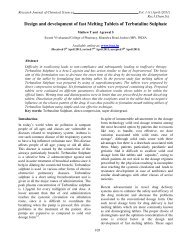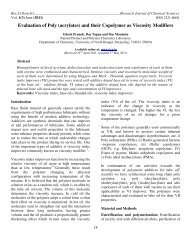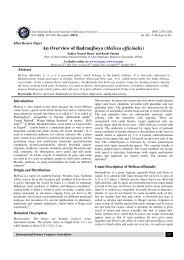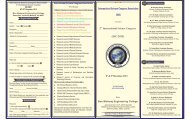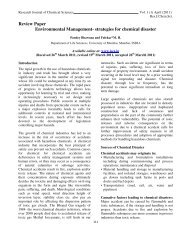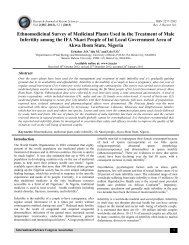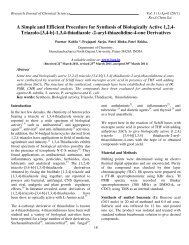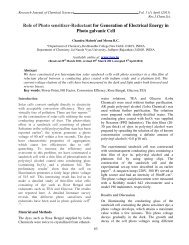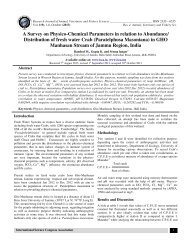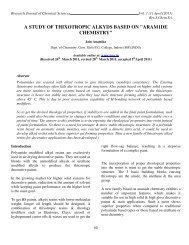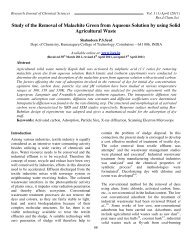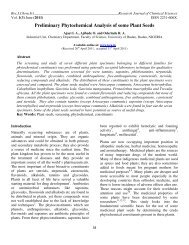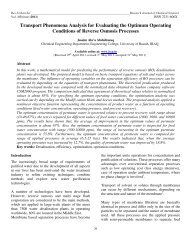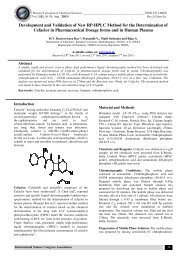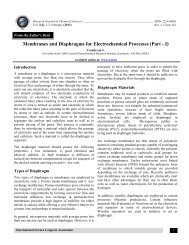Preparation of Low Cost Activated Carbon from Tea Waste ... - ISCA
Preparation of Low Cost Activated Carbon from Tea Waste ... - ISCA
Preparation of Low Cost Activated Carbon from Tea Waste ... - ISCA
You also want an ePaper? Increase the reach of your titles
YUMPU automatically turns print PDFs into web optimized ePapers that Google loves.
International Research Journal <strong>of</strong> Environment Sciences______________________________________________ ISSN 2319–1414<br />
Vol. 2(4), 53-55, April (2013) Int. Res. J. Environment Sci.<br />
Washing <strong>of</strong> the Digested sample: The digested tea waste were<br />
washed using distilled water, 10 to 12 washings were given.<br />
Determination <strong>of</strong> pH: The determination <strong>of</strong> pH <strong>of</strong> the<br />
carbonized material had been done.<br />
<strong>Carbon</strong>ization <strong>of</strong> the sample: The whole sample is taken in a<br />
container and kept at 500 0 C in muffle furnace for 15 minutes.<br />
Then oversize and undersize particle is separated by using 300<br />
meshes.<br />
Feed container: The feed container was a Crucible which could<br />
sustain temperature 500 0 C and above.<br />
Desiccators: The activated carbon was collected in air tight<br />
packets kept inside the desiccators. It keeps activated carbon<br />
moisture free.<br />
Sieving: The carbon obtain <strong>from</strong> above procedure was crushed<br />
manually and passed through the 300 mesh sieve plate to<br />
produce carbon <strong>of</strong> uniform size.<br />
Results and discussion<br />
The studies were carried out with potential adsorbent obtained<br />
<strong>from</strong> tea waste to evaluate its properties as an adsorbent.<br />
Counts<br />
300<br />
200<br />
100<br />
0<br />
<strong>Tea</strong><br />
The parameter chosen for the study and their variations on the<br />
adsorption are depicted in the following manner.<br />
The parameters are: carbonization temperature, pH <strong>of</strong> the<br />
adsorbent, XRD Analysis<br />
Effect <strong>of</strong> carbonization temperature: One <strong>of</strong> the most<br />
important parameter affecting the surface characteristics <strong>of</strong> the<br />
carbon is the carbonization temperature. The carbonization<br />
carried out at 400 0 C to 550 0 C. At 400ºC incomplete<br />
carbonization takes place, at 450ºC complete carbonization<br />
takes place and at 550 0 C the material gets converted into<br />
complete ash form while at remaining temperature carbon<br />
formation occurred. On sieve analysis two particle sizes<br />
obtained i.e. through and above 300 mesh sizes. It is observed<br />
that with the increasing temperature <strong>from</strong> 400 0 C to 550 0 C the<br />
tea waste get converted into carbon and nitrogen packing has<br />
been provided.<br />
The optimum carbonization temperature for the preparation <strong>of</strong><br />
the adsorbent was found to be 500 0 C. The results are shown for<br />
adsorbent with carbonization temperature 500 0 C.<br />
pH <strong>of</strong> the adsorbent: pH <strong>of</strong> the adsorbent is one <strong>of</strong> the most<br />
important factors as we treat the feed with acids and other<br />
chemicals therefore it is necessary to maintain the neutral pH.<br />
20 30 40 50 60 70 80 90<br />
Position [°2Theta] (Copper (Cu))<br />
Figure-1<br />
XRD <strong>of</strong> tea waste (Feed)<br />
International Science Congress Association 54



